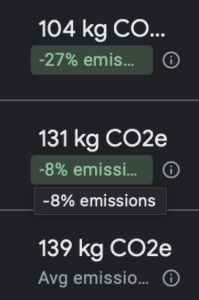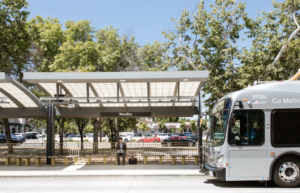So you are interested in reducing your transportation emissions but are not sure where to start? Transportation is a big sector to tackle. It accounts for around one fifth of total global emissions, and it can range from employee commuting, to long-haul business travel, to company fleets. To keep things as simple as possible, we break down transportation into 4 parts:
1: Office Related Transit
2: Business Travel
3: Electric Vehicles
4: Measure and Communicate Impact
This article is designed to help you better understand where your transportation emissions are coming from, and what you can do to decrease them as easily and effectively as possible. Let’s get started!
Part 1: Office Related Transit (Employee Commuting)
There are many ways to reduce your transportation emissions when discussing employee transportation to and from the office, appointments, or site visits. Below we break down the five main ways to effectively reduce emissions from employee transportation.
Step 1: Offer Public Transit Reimbursements
Public transportation is a great option for employees to get to and from the office, as well as appointments and site visits. Some employees may even already be using it. Offering a public transit reimbursement for your employees will not only encourage your employees to use public transit, but will also allow you to better track your company’s carbon footprint.
There are two main ways you can incorporate public transit reimbursements to reduce your transportation emissions. Either offering transit passes, or offering reimbursements for riding in commuter highway vehicles.
Option 1: Transit Passes
Offer discounted or subsidized public transit passes to your employees, making it an attractive and cost-effective option.
In combination with a transit reimbursement, it may be useful to provide information and resources about public transportation routes, schedules, and fares to help employees navigate the system effectively.
Option 2: Commuter Highway Vehicles
Offer reimbursements for riding in a commuter highway vehicle. These vehicles are able to transport several employees at once, reducing the cars on the road and the environmental impact of your employees.
Providing incentives or reimbursements for using public transportation is a great way to encourage employees to move away from driving to and from the office. Some federal, state, and local governing bodies even offer programs or subsidies to promote public transit.
For example, in the United States, the IRS allows employers to provide allowances for transit passes and commuter highway vehicles with pre-tax dollars. Employers can provide up to $315/month* for transit passes for employees. Find out more here.
*$315/month total for transit pass allowances and commuter highway vehicles
Interested in finding out what transit incentives may be available in your area? CarbonSuite can assist with understanding your options or connect you with a local partner.
Step 2: Provide Shuttle Services

If you have many employees commuting from similar locations, or your office is in a location not accessible by public transit, it can be useful to provide a shuttle service to and from your office. This can be a great benefit for employees by providing affordable work transportation, and a great benefit to the environment by reducing your company’s transportation emissions. To do so you can partner with local transit authorities to provide shuttle services between your office and nearby transit hubs, making commuting more convenient for employees.
There are many companies out there offering corporate shuttle services. Need help locating one? CarbonSuite can assist with understanding your options or connect you with a local partner.
Step 3: Encourage Carpooling

Carpooling is a great way to reduce the number of vehicles on the road, thus reducing transportation emissions. Many companies around the world are now implementing programs to encourage employees to carpool to work. Some government authorities are even offering incentives for carpooling within cities to reduce transportation emissions. Here are two tried and true methods for encouraging carpooling in your business:
- Establish a carpool matching program to connect employees living in the same area and encourage them to share rides to work.
- Offer Incentives such as reserved parking spaces or reduced parking fees for employees choosing to carpool.
Step 4: Support Active Commuting


Promoting active commuting options, such as walking or cycling, not only reduces emissions but also promotes employee health and well-being. Here are some ways to support active commuting:
- Create a bicycle-friendly workplace by providing secure bike parking facilities, showers, and changing rooms.
- Offer incentives for employees who choose to walk or bike to work, such as wellness program rewards or extra paid time off.
- Install bike-sharing stations near your office premises to encourage employees to use bicycles for short trips during the workday.
- Host a weekly or monthly active commuting day, offering free lunch or other incentives for those who elect to walk or bike to work.
Step 5: Offer Flexible Work Arrangements

Implementing flexible work arrangements can significantly reduce commuting needs and associated emissions. Flexible hours and remote work options have also become preferred by employees across the world. If possible for your business model, consider the following options:
- Offer remote work opportunities or telecommuting options, allowing employees to work from home a certain number of days per week.
- Implement flexible work hours, enabling employees to avoid peak commuting times and potentially reduce travel time.
Part 2: Business Travel

When it comes to business travel, the best thing you can do is first ask yourself, is this long-distance travel really necessary? If the answer is yes, then carry on and follow our steps listed below to make the trip as sustainable as possible. If the answer is no, then do yourself and the planet a favor and skip it!
So this trip is absolutely vital to your business, what can you do to lower your environmental impact? First, you can consider all your options to determine which is the most eco-friendly, and if possible, try to find an alternative to flying. Flying contributes a significant amount of GHG emissions, so whenever possible, it is best to opt for a more eco-friendly alternative like a train ride.
No alternatives to flying? That’s okay. Next you can have a look at your options for flying. Try to take the least carbon intensive flight possible.
Book the most direct route
Nonstop flights are your best option, as they lower the total amount of time in the air and therefore jet fuel used. They also lower the number of times of take off and landing, which is actually the times where the plane is using the most fuel and therefore emitting the most carbon. Reducing the number of take-offs and landings, reduces transportation emissions, so whenever possible, try to book direct flights.
Look for flights using the least emissions possible
Nowadays you can actually measure the emissions of a particular flight using the Travel Impact Model. Google Flights even has this built into its flight lookup model, so you can clearly see which flights are more emission heavy than others.

Purchase carbon offsets
To neutralize the carbon impact of your flight, you can purchase carbon offsets. Here at CarbonSuite, we can help you calculate the emissions of a particular flight, or of your total business travel, letting you know exactly how many carbon offsets you will need to purchase.
Once you have arrived at your destination, there are still further ways you can reduce transportation emissions. Here are a few further options to keep your trip as green as possible:
Opt for Public Transit
Determine if you really need to rent a car for the trip, or if its possible to get around using public transit. Choosing public transit can help you to get familiar with the area and help lower your overall impact. Even using rideshares such as uber or lyft as opposed to renting a car can help keep your carbon impact down.
Choose environmentally-friendly accommodation
Many hotels are moving to more environmentally friendly practices, like only replacing towels and sheets when requested, or implementing technology to reduce their overall energy usage. These hotels typically have a sustainability policy on their website, so they will be easy to spot.
Business travel can be a huge contribution to overall carbon emissions, and finding a way to measure and reduce your impact can seem daunting. Luckily, here at CarbonSuite we have lots of experience measuring and reducing carbon related to business travel. Send us an email and see how we can help you get started today!
Part 3: Electric Vehicles

Electric vehicles are gaining popularity and are a great option for businesses who spend a lot of time traveling to and from appointments or sites. And they are a great way to reduce transportation emissions! If this sounds like you – upgrading to an electric vehicle fleet may be a great option for your business. Many utility provides even offer incentives to support the transition to electric vehicle fleets. Check out this case study from National Grid, a utility provider in the Eastern United States, documenting one county’s transition to 100% electric vehicles. They received over $100,000 in incentives from National Grid’s Make-Ready program.
Want to learn more about what incentives may be available for your business? CarbonSuite can assist with understanding your options or connect you with a local partner.
You can also check out this article to determine if upgrading to an electric vehicle fleet may be right for your business.
Part 4: Measure and Communicate Impact

CarbonSuite is a great tool for measuring impact related to transportation within your business. Our Built-for-NetSuite SuiteApp allows you to easily measure your carbon impact, enabling you to take accountability for your emissions.
Reach out to our team today to determine how we can help you get started reducing your transportation-related carbon emissions!


